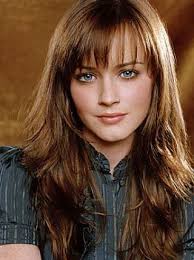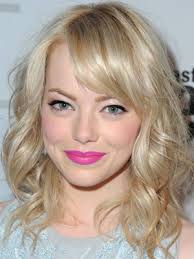Why can some people wear certain hair colors and others can't? This is the question...
For the best outcome when making a haircolor and style change, many aspects should be considered like the current season, clothing selections, skin tone and makeup used.
Here are a few questions to consider:
- Do you look best in cool or warm tones, dark or light?
- What face shape do you have?
- What features do you want to accentuate and which ones would you like to detract?
 As you may notice, just the haircolor alone makes a huge difference in the appearance of complexion, age, and complimentary facial features. Haircolor can either improve or worsen your complexion. If you feel like you are washed out or need a lot of makeup to add brightness then this can be due to a conflict of color.
As you may notice, just the haircolor alone makes a huge difference in the appearance of complexion, age, and complimentary facial features. Haircolor can either improve or worsen your complexion. If you feel like you are washed out or need a lot of makeup to add brightness then this can be due to a conflict of color.
Many people may look blotchy, more red, or drab than what they are use to and this can be a sign of an unflattering color. For example, when you wear certain colors and receive a lot of compliments, and others just wash us out. Color is such an important factor in haircolor, makeup, and clothing. Figuring out what colors look best on you can be done by knowing your color characteristics of undertones, depth, and brightness or clarity. Our hair is a frame to our face and we must find what enhances it the best.
Salon Client Before
 This client wanted to go darker with her hair. Instead of just doing an all-over solid color, a beautiful natural look was created by using at least 2 shades of brown. Sometimes using just one all-over color can look harsh. As we mature, using a little warmth in the hair color can create a youthful look.
This client wanted to go darker with her hair. Instead of just doing an all-over solid color, a beautiful natural look was created by using at least 2 shades of brown. Sometimes using just one all-over color can look harsh. As we mature, using a little warmth in the hair color can create a youthful look.

 Muted - "Muted coloring has a soft, but not delicate, quality that is projected with either light ash blonde hair and dark brown eyes or medium brown eyes and hair. Skin tones range from a very pale, no-color look to soft pink or golden. The complex or no-colors are very complementary on this woman, creating little contrast and more subtle neutral tone."
Muted - "Muted coloring has a soft, but not delicate, quality that is projected with either light ash blonde hair and dark brown eyes or medium brown eyes and hair. Skin tones range from a very pale, no-color look to soft pink or golden. The complex or no-colors are very complementary on this woman, creating little contrast and more subtle neutral tone."

Salon Client After
The following before and after photos are in the same lighting and no added makeup.
 As you may notice, just the haircolor alone makes a huge difference in the appearance of complexion, age, and complimentary facial features. Haircolor can either improve or worsen your complexion. If you feel like you are washed out or need a lot of makeup to add brightness then this can be due to a conflict of color.
As you may notice, just the haircolor alone makes a huge difference in the appearance of complexion, age, and complimentary facial features. Haircolor can either improve or worsen your complexion. If you feel like you are washed out or need a lot of makeup to add brightness then this can be due to a conflict of color.Many people may look blotchy, more red, or drab than what they are use to and this can be a sign of an unflattering color. For example, when you wear certain colors and receive a lot of compliments, and others just wash us out. Color is such an important factor in haircolor, makeup, and clothing. Figuring out what colors look best on you can be done by knowing your color characteristics of undertones, depth, and brightness or clarity. Our hair is a frame to our face and we must find what enhances it the best.
Salon Client Before
 This client wanted to go darker with her hair. Instead of just doing an all-over solid color, a beautiful natural look was created by using at least 2 shades of brown. Sometimes using just one all-over color can look harsh. As we mature, using a little warmth in the hair color can create a youthful look.
This client wanted to go darker with her hair. Instead of just doing an all-over solid color, a beautiful natural look was created by using at least 2 shades of brown. Sometimes using just one all-over color can look harsh. As we mature, using a little warmth in the hair color can create a youthful look.
"Understanding your dominant characteristic will give you the ability to select colors, especially makeup and hair colors, that will always create balance and harmony and look complimentary on you.", says Doris Pooser in her book, "Always in Style".
easiest to see. A deep person has dark
hair and eyes. Skin tone ranges
from light to deep olive. There is a
strength to her coloring.
Dark colors create balance and harmony."
Light - "The light person has light
to medium blonde hair, ash to golden
in hue, light to medium skin tone;
and blue green, or blue green eyes.
Light to medium colors are complementary and create harmony and balance."
Bright - "The bright person has a bright, clear look resulting from the contrast between her dark hair, very light skin tone, and clear blue or green eyes. There is a delicate quality about this woman's coloring that is complimented by clear colors and lots of contrast."
Warm - "The truly golden person has red or golden hair; warm green, hazel, or aqua eyes, and obviously golden, peach, or bronze skin tone. Freckles are often an added feature. Golden, yellow-based colors blend with the richness of her coloring."
Cool - "There are very few, if any, all-cool people. The younger we are the more golden tones we have in our hair and eyes. It is only when we start to age that we lose pigment in our hair, begin to gray and lose color in our eyes and skin tone. It is often best to add some warm tones to create a younger look. However, there are women with ash or gray
hair, rose skin tone, and cool blue or gray eyes who appear to be more
cool than warm. Cooler colors are complementary."
Salon Client After
Salon Client Before
This is a great example of how much haircolor can change someones look and age. The cool tones of gray were enhancing cooler tones in her complexion taking away from youthful warm tones. Adding some beige tones was just enough of cool and warm to compliment her complexion but also keeping it natural.
Eyebrow Color Tip: When changing your hair color don't forget about your eyebrow. A safe rule to balance your eyebrow color and hair. For darker hair keep eyebrows 1-2 shades lighter than your hair. For blondes, make sure your eyebrow color is 1-2 shades darker than your hair.
Keeping to 2 shades darker or lighter for your haircolor is the most natural and flattering in most cases, because you are staying close to all your natural tones - a general rule of thumb in makeup choices.
These color factors are great tools to use when choosing makeup, clothing and hair color that we see in magazines or photos. Considering this information, and discussing it with your hairstylist will create a great foundation for a more beautiful, natural, and complimentary haircoloring service!
ventura, ca
805.628.3535
Find out what your coloring is by answering questions at this website below:





